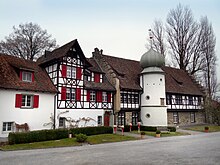Feldbach Monastery
The Klosterfeld Bach was a 1253/1254 founded the abbey of Cistercian nuns on the peninsula Feldbach the historic Thurgau town Steckborn at the Untersee .
history
1252 sold the noble Kuno von Feldbach with the consent of his liege lords , the nobles von Klingen , the castle of Feldbach including patronage rights over the chapel located there as well as the associated vineyard to the sorores in ponte , a community of beguines , in Constance .
After the permission of her professor , the Bishop of Constance , to found the monastery, the Magistra Sophia and her 20 non-regulated Konstanz sisters came to Feldbach in 1253/1254 and took possession of it. On March 1, 1254, the congregatio sanctimonialum in Felbach , i.e. a community of nuns in Feldbach, was documented for the first time. After the sisters had already in 1253 received episcopal permission by the monastic rule of the Cistercian to live, they were in 1256 as monsasterium in Velpach mentioned. In 1260/1262 they were incorporated into the order as nuns .
Thanks to capable abbesses and the favor, among others, of the aforementioned lords of Klingen, the Feldbach Abbey soon acquired considerable and extensive property, for example the bailiwick and the church treasury of Hemmenhofen were transferred to them as early as 1282 . With the abbesses' clever administration, the Feldbach monastery succeeded in creating its own, closed court circle, with which the abbesses became judges for various places and henceforth belonged to the court lords in Thurgau .
In 1327 the Feldbach convent was granted indulgence , probably as a result of the construction of an early Gothic monastery church .
The monastery community consisted of choir wives , lay sisters and so-called conversations , the latter of which existed in Feldbach for an unusually long time, namely until 1333. The choir women were composed mainly of the upper middle class and the lower nobility.
Feldbach Abbey survived the Reformation , due to which in 1549 Ms. Afra Schmid , previously the prioress of the Cistercian Abbey of Magdenau , was appointed abbess to Feldbach, which led the monastery to flourish again. In 1720 the majority of the conventual women (22 choir women and 8 lay sisters) came from Thurgau , the Catholic towns , Swabia and Tyrol .
The flourishing monastery community was able to renovate the church in 1764, among other things. The abbey was abolished in 1848 by resolution of the Grand Council - like almost all monasteries in the canton - in the course of secularization and due to the canton's chronic financial shortage, so that the monastery assets could be confiscated in favor of the canton. The Feldbach Altar was found in an outbuilding .
Due to the ban on using their church, the Feldbach nuns first moved to the Cistercian nuns in the Tänikon Monastery, which was also closed . In 1853, the remaining Feldbach nuns (5 choir women and 4 lay sisters) - after the Tänikon monastery was badly damaged by structural measures by the new owners - moved to Mammern and finally to Gwiggen , where they founded the convent of the combined Thurgau abbeys Feldbach, Kalchrain and Tänikon . The last abbess of Feldbach, Maria Augustina Fröhlich, became the founding abbess of the new monastery.
The monastery buildings of Feldbach burned down almost completely in 1895 due to unrelated, industrial and negligent use. The old monastery , which today serves as part of a hotel, has been preserved.
See also
Web links
- Maria Marcella Kugler: Feldbach. In: Historical Lexicon of Switzerland .
- Feldbach Cistercian Convent on the Alt-Steckborn website
Individual evidence
- ^ History of the monastery on the "Hotel Feldbach" website (PDF, 105 KB)
- ↑ Karl Grunder (Ed.): Cistercian buildings in Switzerland. New research results in archeology and art history. Vol. 1. Zurich 1990, ISBN 3-7281-1772-2 , p. 83 ff.
- ^ Maria Marcella Kugler: Feldbach. In: Historical Lexicon of Switzerland .
- ↑ Karl Grunder (Ed.): Cistercian buildings in Switzerland. New research results in archeology and art history. Vol. 1. Zurich 1990, ISBN 3-7281-1772-2 , p. 94.
- ^ Johann Rudolf Rahn, Johann Nater: The former women's monastery Tänikon. Report house, Zurich 1906.



